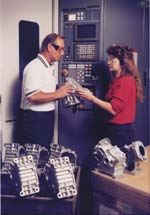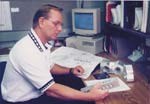Easier, Flexible Estimating Helps Contract Manufacturer
This company used to calculate estimates for parts with a large, internally developed Excel macro, according to their systems administrator. But about 2 years ago, the company went looking for a computer-aided estimating system. Here's what they found.
Share








ECi Software Solutions, Inc.
Featured Content
View More
Hwacheon Machinery America, Inc.
Featured Content
View More
.png;maxWidth=45)
DMG MORI - Cincinnati
Featured Content
View More
Takumi USA
Featured Content
View MoreWith 700 employees and 10 facilities, Citation Custom Products (CCP) produces a total of $115 to $120 million in sales annually. The company's Menomonee Falls, and Oconomowoc, Wisconsin, locations combined have approximately 600 employees and 300 machine tools, including a variety of horizontal and vertical machining centers for both low and high speed machining processes.
The majority of CCP's work, approximately 60 percent, comes from the automotive industry, says senior project manager Art King. CCP supplies first through third tier automotive companies with parts for brake, fuel and steering systems, as well as engine parts.
The company used to calculate estimates for parts with a large, internally developed Excel macro, according to Greg Smith, systems administrator. But about 2 years ago, the company went looking for a computer-aided estimating system.
Ease of use for the entire company was the main reason behind the decision to purchase a dedicated estimating program, according to Mr. King. He said other considerations involved in the decision were the desire for an integrated material library and the ability to work with versatile equipment utilization parameters.
To find a program that offered these features, Mr. King researched products at trade shows and visited other manufacturing facilities to see their estimating systems in action.
In the end, CCP decided to purchase Machine Shop Estimating from Micro Estimating Systems (New Berlin, Wisconsin) because of the system's ability to adapt to different situations that could arise on the shop floor, as well as its ability to calculate estimates using different equipment and types of materials. To make the software even more flexible, Mr. King worked with CCP's machine operators to customize the system's standard speeds and feeds database with machine-specific CCP data.
"I worked with our machine tool people to get the equipment data and parameters to build our own database and to make it a little easier to use various equipment. We did comparisons of jobs on the floor with given rates. I wouldn't say we're 100 percent refined on our numbers, but we have done some studies to try to make it as realistic as possible compared to what's happening on the floor," he says. In addition to the time comparisons, Mr. King also added historical data from the shop floor to the speeds and feeds library. "Because of that information, our speeds and feeds library is almost like a historical document that is continuously updated, depending on the opportunities we have to work with each piece of equipment, and the data that have been collected at that time."
Some of the processes covered in the customized database include new machine tools with higher spindle rpm for high speed machining, using high pressure coolants.
Mr. King created high speed and low speed scenarios in the speeds and feeds library with a directory for each machining style.
"The process was very similar to that of adding historical data," he explains. "Obviously, it's very important to be as accurate as we can. That's why we created the files we have using historical data."
Because of the historical data the shop had available, Mr. King says the amount of time dedicated to the initial customization was not as great as could be expected. That data was combined with information on materials from the program library. Mr. King said he initially used about one-third of the more than 1,100 materials available, and he has gone back to the library for others as they have been needed since.
The company's emphasis on historical data extends to its treatment of the estimates themselves. When orders come in for repeat jobs, having old estimates as historical documents allows CCP to update each bid quickly and easily.
However, due to the design cycles involved with some products, in many cases whatever you're quoting may not become reality for 6 months, or sometimes maybe a year, Mr. King says. "We work with customers on new project design all the way up to current production products. If there is a very similar part, or a repeat, we have the ability to pull up the old information at a later date. We've got easier access to more information than we had before. MSE allows us to maintain historical data, and the quote itself is historical data to us."
With between 15 and 20 seats of MSE on its network, split between project management and manufacturing engineering, CCP developed more than 600 estimates in its first full year using the software. Mr. King credits MSE, and the information stored in its databases, with providing more detailed information for the company's estimating process, including itemized breakdowns of speeds and feeds in comparison to utilization. He says that information makes the firm's estimates more accurate.
"It gives us a little more detail and lets us store, or retain, more data than we used to be able to," he explains.
Related Content
6 Machine Shop Essentials to Stay Competitive
If you want to streamline production and be competitive in the industry, you will need far more than a standard three-axis CNC mill or two-axis CNC lathe and a few measuring tools.
Read MoreERP Provides Smooth Pathway to Data Security
With the CMMC data security standards looming, machine shops serving the defense industry can turn to ERP to keep business moving.
Read MoreCan AI Replace Programmers? Writers Face a Similar Question
The answer is the same in both cases. Artificial intelligence performs sophisticated tasks, but falls short of delivering on the fullness of what the work entails.
Read MoreOrthopedic Event Discusses Manufacturing Strategies
At the seminar, representatives from multiple companies discussed strategies for making orthopedic devices accurately and efficiently.
Read MoreRead Next
Building Out a Foundation for Student Machinists
Autodesk and Haas have teamed up to produce an introductory course for students that covers the basics of CAD, CAM and CNC while providing them with a portfolio part.
Read MoreSetting Up the Building Blocks for a Digital Factory
Woodward Inc. spent over a year developing an API to connect machines to its digital factory. Caron Engineering’s MiConnect has cut most of this process while also granting the shop greater access to machine information.
Read MoreRegistration Now Open for the Precision Machining Technology Show (PMTS) 2025
The precision machining industry’s premier event returns to Cleveland, OH, April 1-3.
Read More





























.jpg;maxWidth=300;quality=90)
















